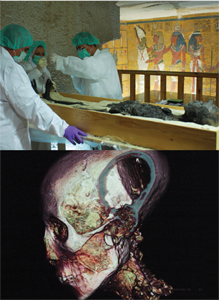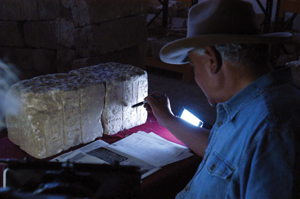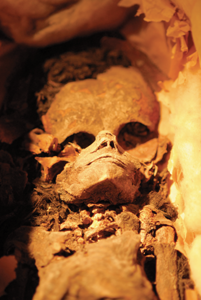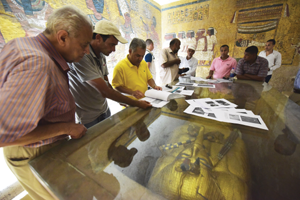

CHAPTER FIVE
NEW DISCOVERIES
.png)
BEN CURTIS/AFP/GETTY
IN 2007, ZAHI HAWASS (center, in hat), then the Egyptian antiquities chief, supervised the removal of Tut’s mummy from his sarcophagus and placed him in a climate-controlled box. The mummy still remains in his tomb in the Valley of the Kings, though most of the other artifacts have been moved for exhibition elsewhere.

“THE STORY OF TUTANKHAMUN IS LIKE A PLAY WHOSE ENDING IS STILL BEING WRITTEN.”
—ZAHI HAWASS, ARCHAEOLOGIST


© BRANDO QUILICI/AGENTUR FOCUS
SINCE CARTER FIRST unwrapped the mummy in 1925, Tut has been the subject of many examinations, including numerous DNA tests, x-rays, and CT scans. Researchers have utilized advancements in science and technology to get a fuller picture of Tut’s life and determine the cause of his mysterious death. The 2005 CT scans disproved a popular theory that Tut died from a blow to the head. Close examination of the skull revealed no head trauma at the time of his death. The crack in his skull was likely caused by mishandling during Tut’s embalming or by Carter and his team.
The fervor for all things Tutankhamun didn’t end in the 1920s, ’30s, ’40s or even the ’70s. Quite the opposite. Interest has continued to grow, mostly fueled by new advances in science and technology.
Since an anatomist named Douglas Derry conducted the first forensic examination of Tut’s mummy in 1925, the young king has been x-rayed, had DNA extracted, and traveled through a CT scanner. Science has led to verifications of his age at death (19) and his height (5'6"), and confirmed a variety of ailments, including a fractured femur, missing ribs, and a cracked skull, as well as several diseases that likely afflicted him.
Based on these findings, experts have presented a wide range of theories about who Tut was and what led to his death. Each theory supports a different—and, in some cases, contradictory—image of the pharaoh. There is evidence for Tut the powerful warrior: He fell off his chariot and died after suffering a broken leg. There is Tut the adventurer: He was mauled by an animal—possibly a hippopotamus—while hunting, which explains his rib-cage abnormalities. There is also enough to support the notion of Tut as the victim of political intrigue: Was he murdered by a power-hungry rival—perhaps his successor, Ay—with a blow to the head?
In 2005, Egyptian officials removed Tut’s mummy from the tomb for the first time since Carter placed him back in 1926, with the intent of examining it with a multimillion-dollar CT scanner brought to the Valley of the Kings. Leading the research was Zahi Hawass, the head of the Egyptian antiquities service. The scan yielded about 1,700 images. Experts, including a paleopathologist and a radiologist, were called upon to give their definitive opinions on the cause of Tut’s death. The conclusion: The pharaoh died from an infection that set in after he broke his leg (though not all team members were so certain that the case was closed).
Meanwhile, DNA testing has confirmed that Tut was the product of inbreeding. As a result, he was a weak boy who suffered from many painful anatomical defects and diseases, including epilepsy. Such a boy was probably not much of a warrior or hunter—and his death was more inevitable than untimely. That same year, documentary filmmakers for the BBC asked paleoartists to construct a lifelike depiction of what Tut might have looked like, using computer technology and forensic data. The result was not flattering. The boy king who was once imagined as the ancient Egyptian version of a rock star now appeared to have an overbite, wide curved hips, and a clubfoot.
But while technology may be eroding the public’s more romantic notions of Tut, the fascination is stronger than ever and the search for new discoveries continues. In 2015, radar testing in Tutankhamun’s tomb uncovered new clues that there is perhaps more to find behind those famous walls. High-resolution images indicate the presence of a sealed chamber. British archaeologist Nicholas Reeves believes that what lies behind Tut’s tomb is yet another ancient royal burial ground—the tomb of Tut’s stepmother, Queen Nefertiti. Reeves believes that Tut’s tomb was originally meant for Nefertiti, perhaps explaining why its size and shape are inconsistent with tombs of other Egyptian kings.

© BRANDO QUILICI/AGENTUR FOCUS
TUT’S TOMB CONTAINED no written record of his reign, so much of his history has been pieced together from other sources. Through his research, Hawass has helped bring clarity to Tut’s life. Hawass performed many DNA tests, including ones on the mummies of two fetuses (one is shown on the below image) found in Tut’s tomb. The tests revealed a high likelihood that they were Tut’s stillborn children with Ankhesenamun. Hawass also discovered a limestone (above) that helped confirm that Tut was the son of Akhenaten, and not a grandson or son-in-law, as it could have been interpreted in other inscriptions.

© BRANDO QUILICI/AGENTUR FOCUS
More tests and analysis remain: Breaking through the sacred walls of the greatest archaeological find in history is not a matter to be considered recklessly. But no matter what is eventually proved to lie behind the walls of Tutankhamun’s tomb—be it newfound gold or pockets of air—this is just the latest chapter in the mystery of Tut and the hidden treasures of Egypt’s ancient civilization.
Science will continue to fuel these new discoveries and advance the theories about who Tut was, what he looked like, and how he died. He will forever remain the most famous king of the ancient world. His was the original grand discovery, the find that defined the modern notion of a worldwide frenzy capable of influencing everything from academia to pop culture. Why do we still care about this 3,300-year-old pharaoh? We care because he represents ideas that matter to us—power, immortality, wealth, youth, and fame. Those ideas are not ancient. They are everlasting.

© BRANDO QUILICI/AGENTUR FOCUS
ARCHAEOLOGISTS LIKE Hawass (above) have been on the hunt for the next great find: Nefertiti and her tomb. In 2003, University of York archaeologist Joann Fletcher theorized that the Younger Lady, a mummy found in the tomb of Amenhotep II, was, in fact, the mummy of Nefertiti. Other experts discounted the notion, and Hawass’s DNA work concluded that the Younger Lady was Akhenaten’s sister— and possibly Tut’s mother. Below: An unfinished head of Nefertiti carved in brown quartzite, circa 1353–1336 BC.

WERNER FORMAN/UNIVERSAL IMAGES GROUP/GETTY

© BRANDO QUILICI/AGENTUR FOCUS
THE SEARCH FOR Nefertiti has brought experts, led by Egypt’s minister of antiquities, Mamdouh Eldamaty (in yellow shirt), back to Tut’s tomb (right). After high-tech infrared and radar scans detected the presence of hidden passages behind the walls of Tut’s burial chamber, archaeologist Nicholas Reeves presented his theory that Nefertiti and her treasures are lying in wait. Reeves believes that because Tut died suddenly, before his tomb was ready, priests may have reopened Nefertiti’s tomb for Tut’s burial. The investigation is ongoing and will take careful planning in order to minimize damage to Tut’s tomb.